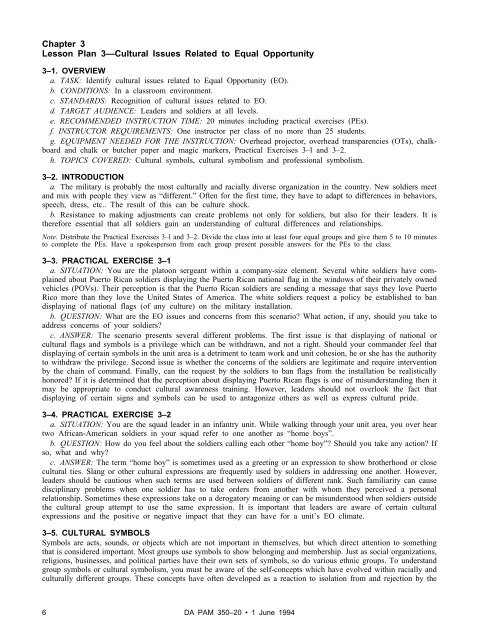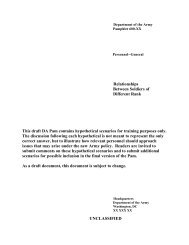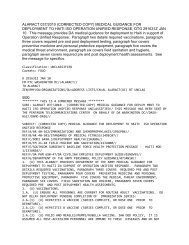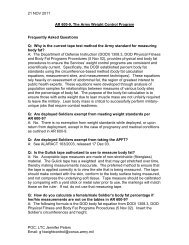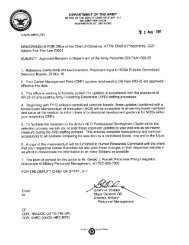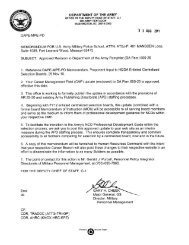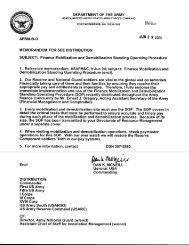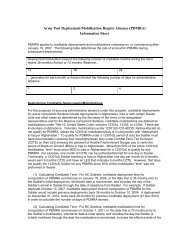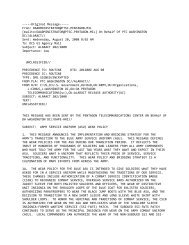Unit Equal Opportunity Training Guide - Deputy Chief of Staff ARMY ...
Unit Equal Opportunity Training Guide - Deputy Chief of Staff ARMY ...
Unit Equal Opportunity Training Guide - Deputy Chief of Staff ARMY ...
You also want an ePaper? Increase the reach of your titles
YUMPU automatically turns print PDFs into web optimized ePapers that Google loves.
Chapter 3<br />
Lesson Plan 3—Cultural Issues Related to <strong>Equal</strong> <strong>Opportunity</strong><br />
3–1. OVERVIEW<br />
a. TASK: Identify cultural issues related to <strong>Equal</strong> <strong>Opportunity</strong> (EO).<br />
b. CONDITIONS: In a classroom environment.<br />
c. STANDARDS: Recognition <strong>of</strong> cultural issues related to EO.<br />
d. TARGET AUDIENCE: Leaders and soldiers at all levels.<br />
e. RECOMMENDED INSTRUCTION TIME: 20 minutes including practical exercises (PEs).<br />
f. INSTRUCTOR REQUIREMENTS: One instructor per class <strong>of</strong> no more than 25 students.<br />
g. EQUIPMENT NEEDED FOR THE INSTRUCTION: Overhead projector, overhead transparencies (OTs), chalkboard<br />
and chalk or butcher paper and magic markers, Practical Exercises 3–l and 3–2.<br />
h. TOPICS COVERED: Cultural symbols, cultural symbolism and pr<strong>of</strong>essional symbolism.<br />
3–2. INTRODUCTION<br />
a. The military is probably the most culturally and racially diverse organization in the country. New soldiers meet<br />
and mix with people they view as “different.” Often for the first time, they have to adapt to differences in behaviors,<br />
speech, dress, etc.. The result <strong>of</strong> this can be culture shock.<br />
b. Resistance to making adjustments can create problems not only for soldiers, but also for their leaders. It is<br />
therefore essential that all soldiers gain an understanding <strong>of</strong> cultural differences and relationships.<br />
Note. Distribute the Practical Exercises 3–l and 3–2. Divide the class into at least four equal groups and give them 5 to 10 minutes<br />
to complete the PEs. Have a spokesperson from each group present possible answers for the PEs to the class.<br />
3–3. PRACTICAL EXERCISE 3–1<br />
a. SITUATION: You are the platoon sergeant within a company-size element. Several white soldiers have complained<br />
about Puerto Rican soldiers displaying the Puerto Rican national flag in the windows <strong>of</strong> their privately owned<br />
vehicles (POVs). Their perception is that the Puerto Rican soldiers are sending a message that says they love Puerto<br />
Rico more than they love the <strong>Unit</strong>ed States <strong>of</strong> America. The white soldiers request a policy be established to ban<br />
displaying <strong>of</strong> national flags (<strong>of</strong> any culture) on the military installation.<br />
b. QUESTION: What are the EO issues and concerns from this scenario? What action, if any, should you take to<br />
address concerns <strong>of</strong> your soldiers?<br />
c. ANSWER: The scenario presents several different problems. The first issue is that displaying <strong>of</strong> national or<br />
cultural flags and symbols is a privilege which can be withdrawn, and not a right. Should your commander feel that<br />
displaying <strong>of</strong> certain symbols in the unit area is a detriment to team work and unit cohesion, he or she has the authority<br />
to withdraw the privilege. Second issue is whether the concerns <strong>of</strong> the soldiers are legitimate and require intervention<br />
by the chain <strong>of</strong> command. Finally, can the request by the soldiers to ban flags from the installation be realistically<br />
honored? If it is determined that the perception about displaying Puerto Rican flags is one <strong>of</strong> misunderstanding then it<br />
may be appropriate to conduct cultural awareness training. However, leaders should not overlook the fact that<br />
displaying <strong>of</strong> certain signs and symbols can be used to antagonize others as well as express cultural pride.<br />
3–4. PRACTICAL EXERCISE 3–2<br />
a. SITUATION: You are the squad leader in an infantry unit. While walking through your unit area, you over hear<br />
two African-American soldiers in your squad refer to one another as “home boys”.<br />
b. QUESTION: How do you feel about the soldiers calling each other “home boy”? Should you take any action? If<br />
so, what and why?<br />
c. ANSWER: The term “home boy” is sometimes used as a greeting or an expression to show brotherhood or close<br />
cultural ties. Slang or other cultural expressions are frequently used by soldiers in addressing one another. However,<br />
leaders should be cautious when such terms are used between soldiers <strong>of</strong> different rank. Such familiarity can cause<br />
disciplinary problems when one soldier has to take orders from another with whom they perceived a personal<br />
relationship. Sometimes these expressions take on a derogatory meaning or can be misunderstood when soldiers outside<br />
the cultural group attempt to use the same expression. It is important that leaders are aware <strong>of</strong> certain cultural<br />
expressions and the positive or negative impact that they can have for a unit’s EO climate.<br />
3–5. CULTURAL SYMBOLS<br />
Symbols are acts, sounds, or objects which are not important in themselves, but which direct attention to something<br />
that is considered important. Most groups use symbols to show belonging and membership. Just as social organizations,<br />
religions, businesses, and political parties have their own sets <strong>of</strong> symbols, so do various ethnic groups. To understand<br />
group symbols or cultural symbolism, you must be aware <strong>of</strong> the self-concepts which have evolved within racially and<br />
culturally different groups. These concepts have <strong>of</strong>ten developed as a reaction to isolation from and rejection by the<br />
6 DA PAM 350–20 1 June 1994


